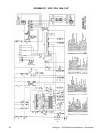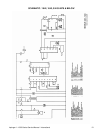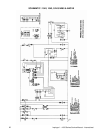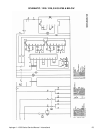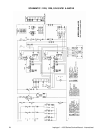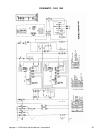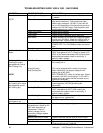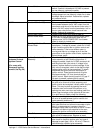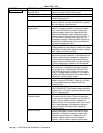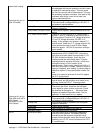
Impinger I -–1000 Series Service Manual - International 28
Flame Sensor (There should be a visible pilot flame at this time.)
To check for proper flame sensor operation,
connect a digital multimeter (capable of measuring
D. C. microamperes) in series between the flame
sensor wire (normally connected to terminal #4)
and terminal #4. NOTE: This is a current
measurement and the meter must be connected in
series. This procedure is for checking the pilot
flame only. Remove main valve wire (Red) from
terminal #3 on ignition control. With a visible pilot
flame, the current readings should be as follows:
Johnson G-65 control, 0.2 micro amp. D.C.
minimum/Johnson G-60 control, 0.7 micro amp.
D.C. minimum. If these values are not achieved,
replace flame sensor. Also check for any type of
damage to flame sensor wire and connections.
Pilot flame but no main
flame
Ignition Control and Valve
Assembly
If there is a pilot flame, and there is sufficient micro
amp. current at terminal #4, check for 24 VAC
that the main valve (internal to valve assembly) has
opened. Connect a manometer to the manifold gas
pressure tap located on the back side of the ignition
control and valve assembly. If no gas is present,
replace ignition control and valve assembly.
Centrifugal Switch of Burner
Blower Motor
NOTE:
Check for 24 VAC output from secondary of
transformer. If voltage is present, check for 24 VAC
at terminals marked "24V" and "24V gnd" on
Ignition Control. If the Burner Blower Motor is
running and there is no voltage at terminals 24V
and 24V gnd on the ignition control, replace the
Burner Blower Motor.
These Ignition Controls have a 30 second pre-
purge(Delay) and a 15 second lock-out time – The
Ignition Control will try for ignition for 15 seconds
and then shut-off. To Re-try for ignition, turn off
burner switch, wait 30 seconds and re-try ignition.
For ovens with
Honeywell ignition
control
Ignition Control Check for 24 VAC supply to ignition control at
terminals "24V" and "24V gnd". If voltage is
present, check for 24V at terminal "P.V. (Pilot
Valve) and "gnd". If voltage is not present, replace
Ignition Control. If the pilot valve is energized,
check to see that the high voltage ignitor circuit is
also energized. To check, disconnect the ignitor
lead from the ignition control. Place the terminal of
ignitor lead approximately 1/8" from terminal post
on Ignition Control. Spark should jump the 1/8"
gap. If no spark is present, replace ignition control.
No Pilot
Pilot Shut-off Valve
If the ignition control is supplied with 24 VAC and
the pilot valve (in gas valve) and ignitor circuits are
energized, visually check for pilot flame. This may
be done by opening the small inspection door on
the end of the burner, or by opening the main oven
door and looking under the lower finger housing in
the right side of the oven.
If no pilot flame is visible, check to see that the pilot
shut-off valve is open (shut-off valve is located
between gas valve and burner).
Pilot Tube Check for gas pressure at pilot tube. Disconnect
pilot tube at burner and connect manometer to pilot
tube. If no gas pressure is present, check for
blockage in pilot tube or pilot shut-off valve.
Pilot Orifice If there is gas pressure at the pilot tube, check the
pilot orifice for obstructions. Replace as needed.



